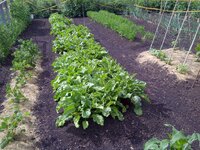Prairie Dog
Well-Known Member
- Region
- Canada
- City
- Red Deer
Cycling has recently taken a back seat so that my wife and I could prepare our city community vegetable plots to kick off the gardening season. It starts with pounding in 30, 7-foot T-posts and wrapping the entire perimeter with fabric mesh to keep the pesky deer out. Our two combined plots measure approx. 60’ L x 20’ W.


So far, we’ve only sowed carrots, beets and corn but the remaining space will be taken up with other veg varieties including broccoli, 4 varieties of onions, Chinese veg, beans, cucumbers, peas, zucchini, Japanese squash, tomatoes, and basil. In addition, we also have our garden/greenhouse back home where we’ll grow peppers, garlic, more beans and Japanese strawberries.
Here’s a sample of what we have harvested in past years. We share the bounty with family, friends, neighbors as well as the local food bank.












So far, we’ve only sowed carrots, beets and corn but the remaining space will be taken up with other veg varieties including broccoli, 4 varieties of onions, Chinese veg, beans, cucumbers, peas, zucchini, Japanese squash, tomatoes, and basil. In addition, we also have our garden/greenhouse back home where we’ll grow peppers, garlic, more beans and Japanese strawberries.
Here’s a sample of what we have harvested in past years. We share the bounty with family, friends, neighbors as well as the local food bank.


















